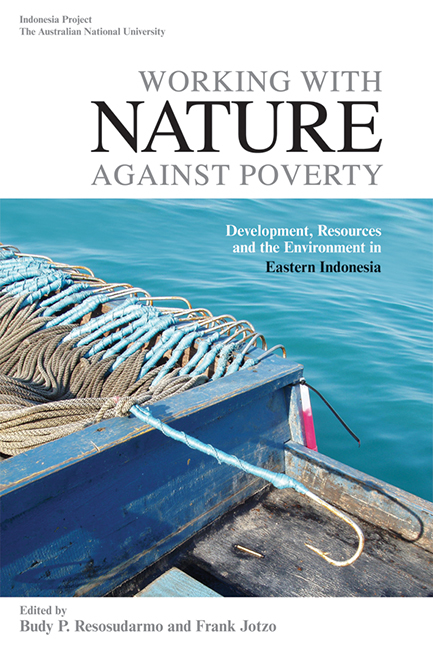Book contents
- Frontmatter
- Foreword
- Contents
- Figures and Maps
- Tables
- Contributors
- Acknowledgments
- Glossary
- Map
- 1 Development, Resources and Environment in Eastern Indonesia
- PART I ECONOMIC DEVELOPMENT AND POVERTY ALLEVIATION
- PART II NATURAL RESOURCES AND THE ENVIRONMENT
- 6 Balancing Biodiversity Conservation and Development in Eastern Indonesia
- 7 Between a Rock and a Hard Place: Corporate Strategy at the Freeport Mine in Papua, 2001–2006
- 8 Illegal Fishing in the Arafura Sea
- 9 Searching for a Livelihood: The Dilemma of Small-boat Fishermen in Eastern Indonesia
- 10 Forest Management and Conflict: The Case of the Rendani Protection Forest in Papua
- 11 Climate Change and Development in Eastern Indonesia
- PART III CONFLICT, LOCAL DEVELOPMENT AND HEALTH
- Index
6 - Balancing Biodiversity Conservation and Development in Eastern Indonesia
from PART II - NATURAL RESOURCES AND THE ENVIRONMENT
Published online by Cambridge University Press: 21 October 2015
- Frontmatter
- Foreword
- Contents
- Figures and Maps
- Tables
- Contributors
- Acknowledgments
- Glossary
- Map
- 1 Development, Resources and Environment in Eastern Indonesia
- PART I ECONOMIC DEVELOPMENT AND POVERTY ALLEVIATION
- PART II NATURAL RESOURCES AND THE ENVIRONMENT
- 6 Balancing Biodiversity Conservation and Development in Eastern Indonesia
- 7 Between a Rock and a Hard Place: Corporate Strategy at the Freeport Mine in Papua, 2001–2006
- 8 Illegal Fishing in the Arafura Sea
- 9 Searching for a Livelihood: The Dilemma of Small-boat Fishermen in Eastern Indonesia
- 10 Forest Management and Conflict: The Case of the Rendani Protection Forest in Papua
- 11 Climate Change and Development in Eastern Indonesia
- PART III CONFLICT, LOCAL DEVELOPMENT AND HEALTH
- Index
Summary
The biodiversity of eastern Indonesia is globally important from both an evolutionary biology and a socio-political perspective. An estimated 12 million Indonesians east of the Wallace line depend directly on biodiversity and ecosystem services for their livelihoods and well-being. Those resources are under increasing pressure as global demand increases, as comparable resources in western and central Indonesia are depleted and as population expands due to in-migration and local economic and population growth. In order to protect food security, sustain livelihoods and conserve critical biodiversity habitat such as coral reefs and forests, we must plan for appropriate use and conservation of biodiversity. In this chapter, we describe some of the challenges to biodiversity conservation in eastern Indonesia, and the innovative approaches being used in North and Central Sulawesi, Komodo and West Papua to conserve biodiversity and secure sustainable livelihoods for local communities.
INTRODUCTION
In this archipelago there are two distinct faunas rigidly circumscribed which differ as much as do those of Africa and South America and more than those of Europe and North America: yet there is nothing on the map or on the face of the islands to mark their limits (Alfred Russell Wallace 1869: 340).
Eastern Indonesia is remarkable for its biological differences to western Indonesia. The line that Wallace drew between the islands of Bali and Lombok, continuing between Borneo and Celebes (now Sulawesi), has become a hallmark of modern biogeography. While there has been much debate subsequently about where that line ought to be drawn and why (Wickramanayake et al. 2002), recent analyses of terrestrial and marine biogeographical patterns (Briggs 2005) have confirmed that, from an evolutionary biology perspective, there is clearly something very special about the flora and fauna of eastern Indonesia.
The so-called Coral Triangle (Djohani et al. 2003) that represents the global epicentre of marine biodiversity covers a larger area than just eastern Indonesia, but the centre of that marine diversity stretches from the Banda Sea to Papua New Guinea, as indicated in Figure 6.1.
- Type
- Chapter
- Information
- Working with Nature against PovertyDevelopment, Resources and the Environment in Eastern Indonesia, pp. 125 - 146Publisher: ISEAS–Yusof Ishak InstitutePrint publication year: 2009



